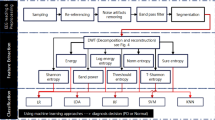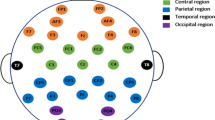Abstract
Parkinson's disease (PD) is one of the most common health problems globally. It is essential to diagnose healthy people and patients with PD precisely. This study contains 28 patients who tested ON and OFF dopaminergic medication and 28 healthy people of matched age and sex. Their electroencephalography (EEG) signals, which were the most frequently employed approach for diagnosing brain illness, were collected while participating in Simon's Conflict for the classification phase. The proposed method consists of preprocessing, feature extraction, and classification. This research used Independent Component Analysis to separate the EEG signal into several components to remove noise. Discrete wavelet transforms (DWT) decomposed the EEG signal to delta, theta, alpha, beta, and gamma bands to extract important information. This research emphasizes using ICA, DWT, and machine learning algorithms to diagnose healthy people and PD. Research also indicated that removing noise from EEG signals was a crucial step, which helped to improve the result significantly. The classification result using linear Support Vector Machine gives the highest performance: 84.5% accuracy, 89.3% sensitivity, and 75.0% specificity.
Access this chapter
Tax calculation will be finalised at checkout
Purchases are for personal use only
Similar content being viewed by others
References
Nussbaum, R.L., Ellis, C.E.: Alzheimer’s disease and Parkinson’s disease. N. Engl. J. Med. 348(14), 1356–1364 (2003)
Berke, J.D.: What does dopamine mean? Nat. Neurosci. 21(6), 787–793 (2018)
Chen, H.L., et al.: An efficient diagnosis system for detection of Parkinson’s disease using fuzzy k-nearest neighbor approach. Expert Syst. Appl. 40(1), 263–271 (2013)
Oh, S.L., et al.: A deep learning approach for Parkinson’s disease diagnosis from EEG signals. Neural Comput. Appl. 32(15), 10927–10933 (2018). https://doi.org/10.1007/s00521-018-3689-5
Loh, H.W., Ooi, C.P., Palmer, E., Barua, P.D., Dogan, S., Tuncer, T., Acharya, U.R.: GaborPDNet: Gabor transformation and deep neural network for Parkinson’s disease detection using EEG signals. Electronics 10(14), 1740 (2021)
Khare, S.K., Bajaj, V., Acharya, U.R.: PDCNNet: An automatic framework for the detection of Parkinson’s disease using EEG signals. IEEE Sens. J. 21(15), 17017–17024 (2021)
Chaturvedi, M., et al.: Quantitative EEG (QEEG) measures differentiate Parkinson’s disease (PD) patients from healthy controls (HC). Front. Aging Neurosci. 9, 3 (2017)
Koch, M., Geraedts, V., Wang, H., Tannemaat, M., Bäck, T.:. Automated machine learning for EEG-based classification of Parkinson’s disease patients. In: 2019 IEEE International Conference on Big Data (Big Data), pp. 4845–4852, December. IEEE (2019)
Cavanagh, J.F., et al.: Cognitive states influence dopamine-driven aberrant learning in Parkinson’s disease. Cortex 90, 115–124 (2017)
Singh, A., Richardson, S.P., Narayanan, N., Cavanagh, J.F.: Mid-frontal theta activity is diminished during cognitive control in Parkinson’s disease. Neuropsychologia 117, 113–122 (2018)
Delorme, A., Makeig, S.: EEGLAB: an open source toolbox for analysis of single-trial EEG dynamics including independent component analysis. J. Neurosci. Methods 134(1), 9–21 (2004)
Ullsperger, M., Debener, S.: Simultaneous EEG and fMRI: Recording, Analysis, and Application. Oxford University Press (2010)
Cardoso, J.F., Souloumiac, A.: Blind beamforming for non-Gaussian signals. In: IEE Proceedings F (Radar and Signal Processing), Vol. 140, No. 6, pp. 362–370. IET Digital Library (1993, December)
Yeredor, A.: Blind separation of Gaussian sources via second-order statistics with asymptotically optimal weighting. IEEE Signal Process. Lett. 7(7), 197–200 (2000)
Langlois, D., Chartier, S., Gosselin, D.: An introduction to independent component analysis: InfoMax and FastICA algorithms. Tutor. Quant. Methods Psychol. 6(1), 31–38 (2010)
Zhou, W., Chelidze, D.: Blind source separation based vibration mode identification. Mech. Syst. Signal Process. 21(8), 3072–3087 (2007)
Sahonero-Alvarez, G., Calderon, H.: A comparison of SOBI, FastICA, JADE and Infomax algorithms. In: Proceedings of the 8th International Multi-Conference on Complexity, Informatics and Cybernetics, pp. 17–22, March (2017)
Vo, T.H.T., Dang, T.L.N., Nguyen, N.V.T., Van Huynh, T.: Classification electroencephalography using machine learning. In: 2019 19th International Symposium on Communications and Information Technologies (ISCIT), pp. 14–19, September. IEEE (2019)
Guo, G., Wang, H., Bell, D., Bi, Y., Greer, K.: KNN model-based approach in classification. In: OTM Confederated International Conferences” On the Move to Meaningful Internet Systems”, pp. 986–996, November. Springer, Berlin, Heidelberg (2003)
Sagi, O., Rokach, L.: Ensemble learning: A survey. Wiley Interdiscip. Rev. Data Mining Knowl. Discov. 8(4), e1249 (2018)
Cavanagh, J.F., Singh, A., Narayanan, K.: EEG: Simon conflict in Parkinson’s. OpenNeuro (2021). https://doi.org/10.18112/openneuro.ds003509.v1.1.0
Pion-Tonachini, L., Kreutz-Delgado, K., Makeig, S.: ICLabel: an automated electroencephalographic independent component classifier, dataset, and website. Neuroimage 198, 181–197 (2019)
Acknowledgments
This research is funded by University of Science, VNU-HCM under grant number T2022–03.
Author information
Authors and Affiliations
Corresponding authors
Editor information
Editors and Affiliations
Rights and permissions
Copyright information
© 2023 The Author(s), under exclusive license to Springer Nature Switzerland AG
About this paper
Cite this paper
Nguyen, TNQ., Vo, HTT., Nguyen, H.A., Van Huynh, T. (2023). Machine Learning in Classification of Parkinson’s Disease Using Electroencephalogram with Simon’s Conflict. In: Huang, YP., Wang, WJ., Quoc, H.A., Le, HG., Quach, HN. (eds) Computational Intelligence Methods for Green Technology and Sustainable Development. GTSD 2022. Lecture Notes in Networks and Systems, vol 567. Springer, Cham. https://doi.org/10.1007/978-3-031-19694-2_10
Download citation
DOI: https://doi.org/10.1007/978-3-031-19694-2_10
Published:
Publisher Name: Springer, Cham
Print ISBN: 978-3-031-19693-5
Online ISBN: 978-3-031-19694-2
eBook Packages: Intelligent Technologies and RoboticsIntelligent Technologies and Robotics (R0)




